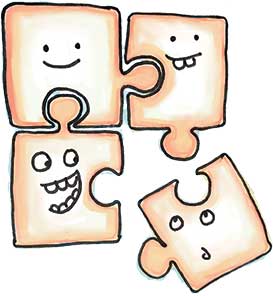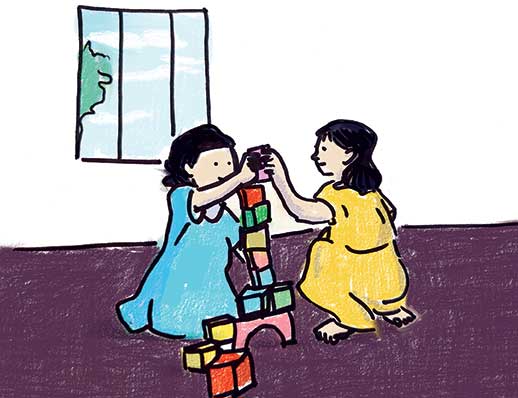Fiona Vaz
In one of my classes, a few years ago, a professor of mine who taught educators how to teach controversial issues to school students, mentioned that patriotism can never be taught. My professor had taught history in primary schools for several years before becoming a teacher educator and knew what he was talking about. I reflected deeply about what he said especially as patriotism curriculum was being introduced in Delhi. Patriotism, like happiness, cannot be taught and must be felt. These are natural outcomes of several factors that cannot be controlled. Several complex factors might influence a person’s feelings of oneness towards one’s country or even what constitutes happiness for someone. If these cannot be taught, then what does the patriotism or happiness curriculum in Delhi, for example offer? The answer to this question lies in the fact that these curriculums are created on principles of social and emotional learning (SEL) skills. In fact, the Happiness Curriculum being implemented in government schools of Delhi is the largest public SEL programme in the world. The aim of SEL programmes is to foster skills in children that will allow them to be more empathetic towards others and also be more aware of their own emotions thus helping them regulate their emotions better. Investing in SEL means that students gain in other areas of their lives too. They might have bigger academic gains, or make healthier choices and be able to regulate their emotions more effectively. However, some questions still remain: do we need to burden teachers who already have a heavy workload with another curriculum? Does everything need to be taught at school? Are homes and communities no longer places that can take on the role of nurturing skills in children? And finally, can we teach children emotional regulation and how to relate to others? These questions prompt a closer look at SEL.
Social Emotional Learning: A practitioner’s definition
According to Joseph E Zins, who in 1995 wrote about the importance of emotional intelligence in academic and learning spaces, SEL is an extension of building emotional intelligence in children. Typically, SEL might be used to address another problem that a school or community might be facing such as drug abuse, bullying, increased mental health conditions, or even drop-outs. Misbah Shahid, who worked with the Teacher Foundation to develop their framework on SEL, mentions that schools could use SEL to curb bullying among students, for example. According to Zins, no matter what its overarching objectives, effective SEL curricula try to build emotional awareness, self-management, empathy, perspective taking and co-operation. Therefore, in order to address bullying, for example, a school might hope that due to the SEL inputs, students are able to be aware of the feelings that lead them to bully others, regulate their emotions so that they are able to find ways to express themselves better and also empathize with the one they might be bullying.

It is believed that SEL classes also have beneficial effects on overall student wellbeing. Feeling happier, safe with friends and teachers and accomplished in handling learning load, can lead to students performing well in school as well as in other areas of life. SEL inputs, are therefore hoped to have more holistic effects on students outside of schooling. Better ways of relating with others can encompass family members as well as neighbours, community members and society at large. Finally, SEL programmes are known to affect the school culture. In general, various research point out that students tend to feel freer because SEL classes create an atmosphere where teachers and students can discuss issues of a personal nature freely with each other. Students have a caring adult to turn to and because teachers have fostered a safe space, they are more welcoming of students expressing their needs. As teachers and other school staff are also familiar with students’ new learning and are committed to providing safe spaces to practice these behaviours and mindsets, the culture of the school changes to attend to students’ emotional risk taking. Shahid defines SEL as something that is more evolving, organic and comprehensive. Evolving and organic because SEL has to be responsive to the immediate needs of the students and comprehensive because, it brings into focus, something that gets easily neglected in schools as well as elsewhere – emotions and feelings. Sarita Pramod Yadav who works as an SEL facilitator in NMMC School-93 in Navi Mumbai, goes a step ahead and says that SEL “is definitely a journey of the heart and mind, but also an exploration of the body. As students are engaged and fully involved, they are able to practice these new learnings and embody new attitudes.” Yadav, therefore through her definition, adds to the cognitive and emotional aspect, by referring to the body, where new learnings are practiced and internalized. This attention to practice is crucial as we will see.
How do teachers incorporate SEL into their instructions?
A standard practice in several syllabi, and in fact even the Bloom’s taxonomy, is to start from the most obvious and immediate and move towards more abstract and application-based learning exercises. A textbook used in SSC schools in Maharashtra, for example, will have a final question that encourages students to go beyond the factual questions and exercises to use their imagination and explore wider topics. These topics are often writing prompts that allow students more freedom than what is traditionally available in the classroom. Unfortunately, these last questions are optional, often unexamined and not discussed. However, looking closely, these questions prompt student thinking and in many ways provide them the opportunity to examine their thoughts and emotions more deeply yet within the boundaries of the main curricular topic. Are these questions embedded in the existing curriculum inadequate to push students to engage with more complex issues? Indeed, given the workload in schools, teachers skip these questions and therefore, it is possible that SEL related topics might not be addressed in schools, if not enforced in some way.
Shahid mentions that SEL inputs have to be continuous and sustained over large periods of time for them to bear results. She shares how SEL is rigorous, structured and must be imparted through planned sessions. There are three ways that teachers generally incorporate SEL in their classes; one is through a specific SEL class, second is by embedding it in the classroom processes such as during transitions and third is through incorporating it in their lessons. A specific SEL class could be through a moral science class, where students and teachers devote time to talking about themselves, their days and so forth. During transitions, teachers might notice that children need to ground themselves and might introduce an SEL-related practice such as breathing, meditation or other forms of grounding and finally, through embedding it in their actual lesson plans. Shahid shares how teachers have used age-appropriate activities such as storytelling, journaling, film screenings and even debates and discussions to improve students’ recognition of their emotions and building empathy. Faria Samreen who is the Life Skills Mentor and Counsellor at DPS Bangalore South emphasizes the importance of quality circle time with students. These circle times done first thing at the start of the school day can set the tone for the day. Finally, Yadav, mentions that SEL practices are not only for children but also for teachers. As much as teachers practice it themselves, they are able to incorporate them better in their classes. In Yadav’s school, SEL practices are often used during staff meetings, parent-teacher meetings as well as other committee meetings. During the COVID-19 pandemic related school closures, all stakeholders were part of SEL during online classes and meetings. There are also SEL champions in NMMC-3 school that ensure that SEL efforts are sustained and returned to at the right opportunities. These include reminding teachers, parents and students of grounding techniques or using them during transitions.
Shahid, mentions that for the SEL practices to be a success, the school culture needs to be a safe space first. Once that is achieved, it makes practicing SEL much simpler. At the same time, practicing SEL leads to the school becoming a much safer space, hence one might wonder, what comes first. However, one might even conclude that given the cyclical relationship between the cause and effect, it might not matter where one starts as long as one does.

Gains for students
As mentioned earlier, incorporating SEL into schooling processes has several potential gains for students. Although longitudinal research in India has not been conducted, such research from other parts of the world, has shown increases in pro-social behaviours, reduction in disruptive behaviours and better academic performance of students. In fact, the Happiness Curriculum in Delhi Schools is being implemented to counter the interference posed by the challenging backgrounds that students belong to and to enhance their learning outcomes. Shahid states that students definitely perform well academically on account of SEL practices. Fear and anxiety in students interfere with memory thereby affecting learning. However, these gains are not easy to come by. In order to see results, it is essential that these SEL activities are practiced over time with a clear objective. Yadav mentions that it is only after three years of sustained inputs that students are now showing a fairly advanced vocabulary in describing their feelings and ease around adults. Samreen, on the other hand, cautions that not all SEL efforts can bear fruit if the right platform is not provided to students to practice these behaviours. “Students feel threatened to try out new behaviours and become more empathetic. They can be judged for being too empathetic.” Backlash from peers, even unknowingly, can be a huge deterrent for SEL gains to materialize. Although it does take us back to the question, what does one need first, a culture to start SEL or SEL to create culture, it is a risk that educators might want to take.
Therefore, SEL might seem like something that was already existing in schools and is now only being focused on in a more intentional way. The rise in pressures that students face requires that all institutions create safe spaces for children. However, SEL is not something that can be neatly compartmentalized into a single time period or part of life. It needs to be constantly reinforced and referenced in other areas across class periods and schooling. Parents could also be encouraged to adopt a greater understanding of SEL and reinforce these learnings at home. As Shahid mentions, SEL lends itself to so many ways of being imparted that it allows the teacher to be creative and incorporate it in the smallest to the biggest ways. After all, as Yadav says, the more she has been able to practice SEL in school, the more she has been able to enrich herself – both professionally and personally.
The author is the co-founder and director of InteGRAL, a gender focused research and consulting firm. She can be reached at fiona@integral-asia.org.
Related Article
